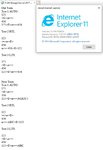hi
when i try to concatenating some str to one
the order is change
for example
str1 =number
str2 = hebrew
str3= number
the str3 concatenating to str1 and not to str2 i guess (if i concatenating with "," is should be ok but i
want fixed length
some explain:
i loop via list dictionary to get length and tag <> (from xml)
after i loop via xml (treat xml like txt)
and get the value between TAG compare list exist and txt/xml exist if match i
get the value between tag and concatenating till end of list dictionary
the problem:::::
the concatenating not by order because the hebrew is RTL i guess
any suggestions?
thanks
when i try to concatenating some str to one
the order is change
for example
str1 =number
str2 = hebrew
str3= number
the str3 concatenating to str1 and not to str2 i guess (if i concatenating with "," is should be ok but i
want fixed length
some explain:
i loop via list dictionary to get length and tag <> (from xml)
after i loop via xml (treat xml like txt)
and get the value between TAG compare list exist and txt/xml exist if match i
get the value between tag and concatenating till end of list dictionary
the problem:::::
the concatenating not by order because the hebrew is RTL i guess
any suggestions?
thanks
C#:
for (int index = 0; index < dict.Count; index++)
{
var item = dict.ElementAt(index);
var itemKey = item.Key;
var itemValue = item.Value;
// int x = Int32.Parse(itemKey);
StringBuilder builder = new StringBuilder(itemValue);
builder.Replace("<", "</");
int lengthh = builder.Length;
StringBuilder builderWO = new StringBuilder(itemValue);
builderWO.Replace(">", "/>");
foreach (string line in lines)
{
int theFirstLen = line.Trim().IndexOf(itemValue);
int theLastLen = line.Trim().IndexOf(builder.ToString());
int theLastLenWO_OPEN = line.Trim().IndexOf(builderWO.ToString());
if (theFirstLen >= 0 && theLastLen > 0 || theLastLenWO_OPEN >= 0)
{
if (theLastLenWO_OPEN >= 0) //mean that we need to put spaces only
{
SR_LEFT = SR_LEFT + "{" + i + ",-" + itemKey.Substring(0, itemKey.IndexOf(".")) + "}";
Console.WriteLine(itemKey.Length - itemKey.IndexOf("."));
SR_RIGHT = SR_RIGHT + new string(' ', Int32.Parse(itemKey.Substring(0, itemKey.IndexOf("."))));
i += 1;
break;
}
else
{
// Console.WriteLine(line.Trim().Substring(theFirstLen + lengthh, theLastLen - theFirstLen - lengthh));
SR_LEFT = SR_LEFT + "{" + i + ",-" + itemKey.Substring(0, itemKey.IndexOf(".")) + "}";
SR_RIGHT = SR_RIGHT + line.Trim().Substring(theFirstLen + lengthh, theLastLen - theFirstLen - lengthh);
i += 1;
break;
}
}
}
}
using (StreamWriter sw = new StreamWriter("C:\\TST.TEXT", false))
{
sw.WriteLine(SR_LEFT, SR_RIGHT);
}
Last edited by a moderator:




